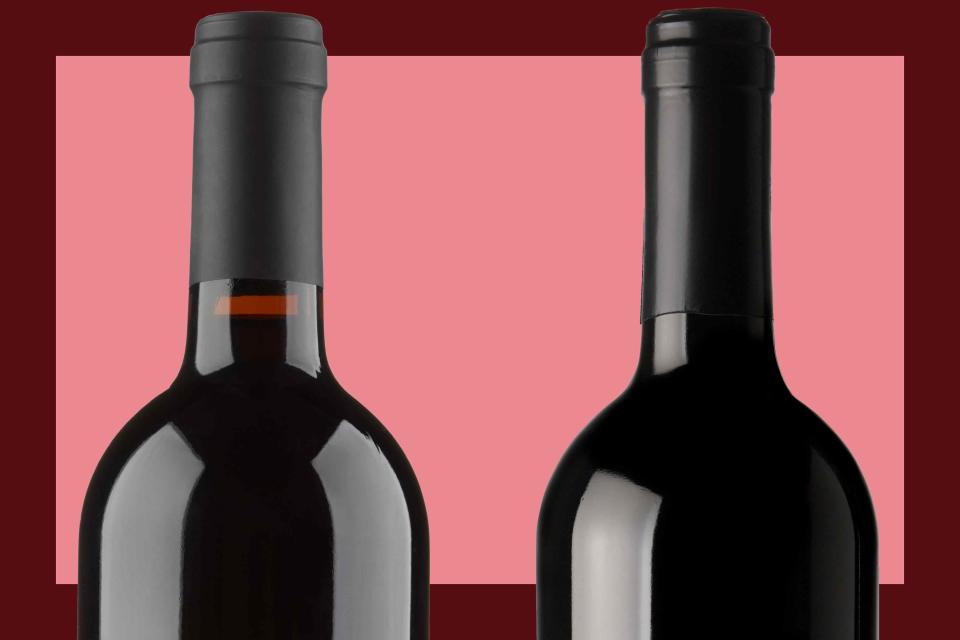Are You Team Cab or Team Merlot?
These two red wines are similar, but it's important to be able to tell them apart.

Food & Wine / Getty Images
Beloved by consumers and professionals alike, Cabernet Sauvignon and Merlot are responsible for producing some of the world’s most coveted wines, as well as some of its most accessible. But what are the key differences between two of the most popular red wines in the world?
“If you enjoy wines with bolder flavors, higher tannins, and more structure, Cabernet Sauvignon works well,” says Steven Karataglidis, director of wine for Fairmont Royal York in Toronto. Karataglidis adds that Merlot is a more suitable option for those with a preference for smoother, more fruit-forward wines.
Cabernet Sauvignon-based wines typically have higher acidity, as well as higher tannin levels due to the grapes’ thicker skins. “This contributes to their firm and structured mouthfeel,” says Karataglidis. He views Cabernet Sauvignon wines as tending to be more robust and full-bodied, whereas the lower acidity and softer tannins of Merlot-based wines render them more velvety and approachable in texture.
In terms of flavor, Maris Hudson, general manager at Hudson House in Nyack, New York, says that Cabernet Sauvignon often shows flavors of darker stewed fruits, as well as an herbaceous, bell pepper quality, whereas Merlot offers more fruit-driven flavors of black cherry, plum blueberry, and chocolate.
“While they both have incredible aging potential, Merlot is usually ready to play a bit younger,” she says.
Related: How to Tell the Difference Between Chardonnay and Pinot Grigio
Best regions for Cabernet Sauvignon and Merlot
Cabernet Sauvignon and Merlot are both cultivated worldwide and benefit from different soil and climate conditions.
Chris Struck, a New York-based beverage educator and sommelier, cites Bordeaux, Napa, California, and Washington State as prime domestic growing regions for both varieties. Internationally, they often thrive in parts of Tuscany (Bolgheri), Chile (Central Valley, particularly the sub-regions of Apalta and Atacama), Argentina (Mendoza, specifically the sub-regions of Maipú and Tupungato), Australia (McLaren Vale, Coonawarra, and Margaret River), and South Africa (Stellenbosch for both varieties, along with Franschhoek for Cabernet Sauvignon).
Struck notes that climate change is impacting the landscapes of traditional regions, as temperature shifts and erratic weather patterns have caused certain grape varieties to perform differently in their standard growing areas. In practice, this means that new regions suited to these varieties are regularly being discovered.
Both Cabernet Sauvignon and Merlot thrive in different soil types. “Bordeaux’s Left Bank is gravelly and offers great drainage, which is a major perk for Cabernet,” explains Hudson. On the contrary, the Right Bank’s clay-heavy soils are often more suited to Merlot, as they offer an optimal environment for the variety to thrive.
“Gravel allows for greater drainage, which keeps the roots, or ‘feet’ of Cabernet plants from getting soggy—which it does not like,” Struck elaborates. On the other hand, he describes Merlot as “a bit thirstier,” which allows it to benefit from the slow-release access to moisture afforded by soils rich in clay.
Related: What Is the Difference Between Merlot and Pinot Noir?
How to pair Cabernet Sauvignon and Merlot with food
Bobby Snyder, beverage director and sommelier at Yingtao in New York City, says that Merlot’s slightly softer tannins and more plum-like fruit flavors can lend it to a wider range of pairing options, especially those that Cabernet Sauvignon might overpower.
“Merlot is especially delicious when matched with meat that has been slow-cooked, such as in a stew or bolognese,” says Snyder. Karataglidis finds that Cabernet Sauvignon pairs best with bold and hearty dishes, like roasted beef or lamb. “The tannins help cut through the richness of fatty meats,” he says.
The high tannins in Cabernet Sauvignon also play well with the fat found in hamburgers. Sauced meats (barbecue included), mushrooms, certain moles and curries, and a variety of cheese-based dishes are capable of standing up to the wine’s present yet more approachable tannins.
Overall, Struck notes that despite the unfair damage done to Merlot’s reputation that many credit to the 2004 film Sideways, the grape is absolutely capable of producing delicious wines that often have less need for bottle age than their Cabernet Sauvignon-based counterparts.
“Because of its comparable lesser demand to Cabernet, Merlot can often overdeliver more easily on quality at various price points,” says Struck. Or, as Hudson sums it, “I think of Cabernet Sauvignon and Merlot as the Bert and Ernie of varieties — of course, they stand alone on their own merits, but no one can argue that they make a great pair.”
For more Food & Wine news, make sure to sign up for our newsletter!
Read the original article on Food & Wine.


